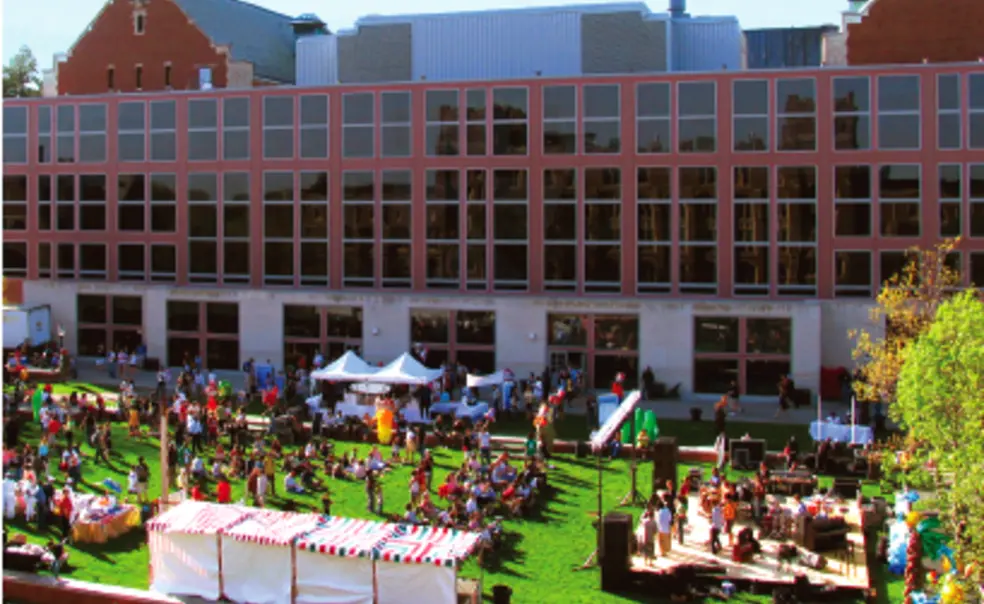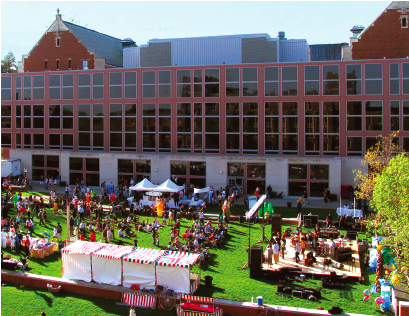The Frist Campus Center Turns 10
The Alumni Weekly provides these pages to the president.
It is hard to believe that a decade has passed since the Frist Campus Center opened its doors, and harder still to imagine Princeton without its vibrant presence. But as most of you know from firsthand experience, we lacked this central feature of collegiate life until the new millennium, when the call of President John Grier Hibben, Class of 1882, and many others for “a common ground for campus life” was finally answered. Even then there were some who doubted whether students, faculty, and staff would leave their scattered niches and congregate beneath one roof—a skepticism underscored by a cover of the PAW from the fall of 2000. “The $48 million bet,” it read. “Princeton hopes the new Frist Campus Center can unite the university community.”
Well, unite us it did, as Princetonians—from freshmen to senior faculty; from grounds and building crews to office staff—gravitated to what is now acknowledged as the epicenter of our campus. In its first year, to the surprise of even its most ardent proponents, Frist hosted some 8,000 events—a plethora of parties, classes, performances, and meetings—and this number has more than doubled since then, overwhelming initial expectations that an administrative staff of three, supported by 10 to 15 students, would be sufficient to keep Frist running smoothly. Today, 10 staff and 80 to 100 students provide the energy and creativity that enable Frist to operate up to 20 hours a day and around the clock during reading and exam times. If anyone doubted its value as a focal point for our community, those doubts were dispelled in the wake of the terrorist attacks of September 11, 2001, when Frist became a gathering place and communications and counseling hub for the entire University. In that moment of anger, fear, and grief, the true importance of “common ground” became apparent.
The keys to Frist’s success are many, not least the vision of its architect Robert Venturi ’47 *50, the generosity of the Frist family, and the inspired leadership of the center’s first director, Paul Breitman, and his successor, Tom Myers. But three stand out as quintessentially Princeton.
The first is Frist’s inclusiveness. It is a place where everyone, not just students, can feel at home and where programs are designed with everyone in mind. Each spring, for example, the center sponsors Fristfest, which celebrates the end of the academic year with entertainment, games, and abundant food and drink. Winterval, another Frist initiative, marks the holiday season, and even in summer, an outdoor concert series draws throngs of University employees, their families, and local residents. In the same spirit, Frist is much more than a social nexus for the University. Fourteen classrooms draw students and faculty from multiple disciplines; the Women’s and LGBT centers support their respective communities while enriching Princeton as a whole; the Pace Center, soon to be joined by the Student Volunteers Council, opens doors to myriad forms of civic engagement; the McGraw Center for Teaching and Learning fosters the pedagogical development of faculty and students alike; and the East Asian studies department and program, including their splendid library, bring specialized scholarship to the heart of University life.
The second key to Frist’s success is its seamless integration of old and new. Architecturally, it combines the collegiate Gothic charm of Palmer Hall with the expansive spaces and soaring wall of glass that we have come to associate with new additions to our campus. That particular wall, with its embedded University shield, can be seen each week in the opening scenes of the TV series House, where it portrays a modern hospital! Inside, of course, you will not find surgery suites, but you will find a lecture hall on the third floor that combines century-old wooden desks with state-of-theart projection technology. Traditions old and new abound throughout the center in the form of Princetoniana, be it wall quotations from the likes of Adlai Stevenson ’22 and Wendy Kopp ’89 or a 19th-century bell from Nassau Hall, complete with a clapper restored by an anonymous—and repentant?— alumnus from the Class of 1956 on the occasion of his 50th reunion.
Finally, Frist is exceptionally responsive to the needs and interests of its users, and from the outset let its policies and programs grow organically rather than foreordaining them. A 17-member Center Stage Student Program Board directs much of Frist’s activities—from game to jazz to craft nights— and the first order of business as Frist embarks on its second decade is conducting a comprehensive user survey to ensure that it continues to reflect the aspirations of our University community.
This, then, is Frist at 10—a microcosm of our larger campus, a fusion of past and present, and a place that students, faculty, staff, and alumni proudly call their own.














No responses yet